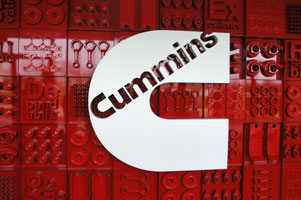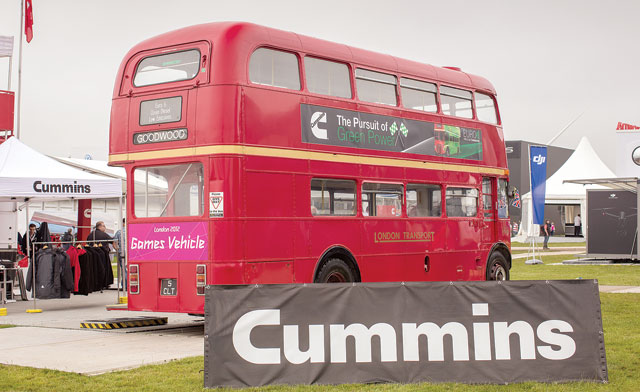IAA Notebook: News From Cummins, Eaton, Dana, Volvo and More

HANOVER, Germany — With more than 2,000 exhibitors from all over the world at the 2016 IAA Commercial Vehicles Show, it can be a difficult process for industry suppliers to gain the attention of visitors. This year, the Sept. 21 media day featured more than 70 press conferences, many convening simultaneously on opposite ends of the Hanover Fairground.
Highlights from the show:
 Wabco demonstration courtesy of IAA
Wabco demonstration courtesy of IAA • Jacques Esculier, chairman and CEO of Wabco, made several announcements, including a deal to join forces with Mobileye N.V. Esculier said Wabco’s advanced emergency braking, active steering and other functionality can combine with Mobileye’s vision system technology to create a “cocoon of safety around the commercial vehicle through 360-degree sensor detection.”
Esculier also announced Wabco has agreed to work with Peloton Technology to advance truck platooning. He declined to provide additional details, other than saying Wabco’s offerings can work in conjunction with Peloton’s system to make platooning a reality in the coming years.
“Today’s announcement builds on our past work together, and we continue to be excited about the synergy with Wabco, a global technology leader in advanced driver assistance and active safety systems,” Josh Switkes, Peloton CEO, said in a statement. “Working with Wabco we can make trucks and drivers safer on highways whether in platoon or operating individually.”
Esculier also said Wabco signed a memorandum of understanding with an automotive supplier from Asia to bring active steering and other technologies to the commercial industry through a new joint venture.
“As our industry converges toward autonomous driving, Wabco continues to advance on multiple fronts to help develop and deliver the essential technologies required to turn this vision into reality,” Esculier said. “Collaborating with Peloton, joining forces with Mobileye and pursuing our vision to bring active steering into Wabco’s vehicle control capabilities represent three major steps forward.”
Analyst Michael Baudendistel of Stifel wrote after his trip to IAA that “Wabco intends to be an integral part of the upcoming automated, semi- autonomous and fully-autonomous driving future, which is bolstered by its recently announced partnership with Mobileye.”
• Continental shared several of its updated safety technologies for trucking, including its head-up display, or HUD. The display projects a color image of important driving information into the field of vision of a driver. Display choices include speed, navigation instructions, traffic sign warnings and driving time remaining.
“The head-up display makes a significant contribution to road safety. The driver can monitor events without getting tired because his eyes don’t have to continually switch back and forth between long-distance and short-range focusing,” said Michael Ruf, head of Continental’s Commercial Vehicles and Aftermarket unit. “The HUD is also an important technology in terms of the progressive automation of driving, because in its role as a human-machine interface, it can ideally provide the driver with information about the current automation mode.”
The company also showed ProViu Detect, which can see the positions of road users and actively warn drivers when there is a risk of collision. In particular the system is meant to assist truck drivers on right turns.
The system’s algorithm uses sensor data to detect pedestrians and cyclists and can show them on an onboard display.
In addition, Continental said more than 400 million Euros have now been saved since the launch of its eHorizon technology in 2012. The sensor system uses topographical route data and a GPS signal to provide information about the road ahead. It is developing dynamic eHorizon, which the company said “forms an important basis for automated driving” by prompting the vehicle to coast or shift down a gear when it detects a traffic jam or other unexpected conditions ahead.
 ZF event courtesy of IAA
ZF event courtesy of IAA • ZF featured its Innovation Truck 2016, which the company said includes the world’s first brake assist and assisted emergency steering control systems for heavy- duty trucks.
“We are aligning our products with the major trends of automation, networking, safety and electrification,” ZF CEO Stefan Sommer said.
Developed with Wabco and demonstrated to reporters earlier this year, the evasive maneuver assist technology automatically steers trucks around dangerous situations to prevent rear-end collisions.
The truck included a virtual reality demonstration and is part of the company’s “See, Think and Act” slogan.
The company is attempting to acquire brake manufacturer Haldex, which Sommer said could be another in a string a recent acquisitions designed to enhance ZF’s position in autonomous and safety technology development. Haldex CEO Bo Annvik attended ZF’s press conference and briefly addressed the media alongside Sommer.
Sommer also confirmed ZF’s plans to build a technology center in India. Once opened in 2020, 2,500 engineers will focus on “software development to enhance the intelligence of vehicle electronic control units,” according to ZF.
 Cummins Inc.
Cummins Inc. • Cummins Inc. showed a number of diesel engine efficiency advancements for the European market, as company executives also made the case that the company would remain a key player in the global trucking industry for years to come.
“We will drive diesel technology ahead so it remains an environmentally responsible choice to power transportation vehicles, but at the same time we are working on expanding our technical portfolio to meet the requirements with other technology options, including alternative fuels, hybrid and electric powertrains and other power technologies of the future,” said Jennifer Rumsey, Cummins chief technology officer.
The Columbus, Indiana-based manufacturer revealed the next generation X Series engines to meet Euro 6 emissions standards. The X Series share a similar platform with the X15 and X12 recently launched for the North American market that meet the U.S. greenhouse-gas standards.
Cummins also unveiled new turbocharger components and a midrange fuel system that combined can offer up to 7% to 8% fuel efficiency improvements. Additionally, Cummins demonstrated a new aftertreatment solution with the unveiling of the new higher performance compact box and display of the single module that offers a 60% reduction in space and 40% reduction in weight.
At its exhibit hall booth, Cummins featured a 54-year-old London Routemaster double-decker bus that meets emissions regulations taking effect in January. The bus, which entered service in 1962, has the distinction of being the oldest, cleanest bus operating in Europe, it said.
“We are delighted that RM1005 has made the journey from London to feature at IAA in Hanover, because this project demonstrates how even the oldest buses in operation can be repowered to meet the most stringent emissions standards,” said Ashley Watton, Cummins director for on-highway in Europe.
Cummins also pointed out that nearly 60% of all of the trucks and buses on display throughout IAA include components engineered and manufactured by Cummins.
Meanwhile, the recent Volkswagen-Navistar deal and continued vertical integration push by vehicle manufacturers has raised some questions regarding Cummins’ ability to remain successful in the trucking space.
In response to media questions, CEO Tom Linebarger was blunt in his assessment:
“My belief is that Cummins will remain an engine supplier, and the reason I think that is as much vertical integration as has happened, there is essentially one engine supplier. So what it means is fewer total opportunities out there but there are fewer suppliers,” he said, adding that it is not “financially attractive” for an OEM to provide every single engine.
• Eaton Corp. displayed a variety of advancements, including a system that will allow for self-docking of a truck. Called Dock Assist, the new feature uses software upgrades to communicate with Eaton’s automated manual and dual-clutch automatic transmissions. The company said by controlling the vehicle speed, Dock Assist can eliminate damage to a trailer and loading dock.
Eaton said as a vehicle moves toward the loading dock, the driver applies the service brake, comes to a stop and then activates the system. Though it is an autonomous function, the driver must remain in the seat during the maneuver. That may not be required in the future, however, director of engineering Larry Bennett suggested.
The company’s announcements here also included the launch of IntelliConnect, a remote diagnostics system that monitors fault codes and transmits them in real time.
In addition, Eaton showcased several waste heat recovery system concepts that Bennett said could one day improve diesel engine fuel efficiency by 20%. The technology is viewed by many as a required piece of meeting greenhouse-gas regulations for 2027.
• Volvo Trucks highlighted the strength of its vertical integration strategy and the launch of an optimized version of the FH model.
“By developing and manufacturing the engines and transmissions ourselves, we can ensure optimal integration and communication between the components to achieve the best possible balance between excellent performance and low fuel consumption,” Volvo President Claes Nilsson said at the company’s press conference.
He said the I-Shift transmission is ordered by 92% of customers globally, and that percentage is even higher within Europe. The automated manual transmission is celebrating its 15th anniversary this year.
The FH “Performance” special edition offers European customers a 540-horsepower engine with the I-Shift dual clutch transmission, Volvo’s dynamic steering and its latest technology and connectivity software. The vehicle is embellished with a large Swedish flag on the outside.
Nilsson also shared a video of Volvo’s autonomous-driving truck being used in mining operations in northern Sweden. When fully operational, the self-driving truck will cover a distance of about 4.4 miles, reaching more than 4,400 feet underground. It will travel down to the loading area where the mining is done and then to an area to drop its load.
Nilsson also teased details about Volvo’s new European-style concept truck, one he said can reduce fuel consumption by about 30% through ”groundbreaking powertrain technology.” He said additional information about this truck would be forthcoming in the near future.
 Dana booth by Neil Abt/Transport Topics
Dana booth by Neil Abt/Transport Topics • Dana Inc. said its Spicer global single axles, available for pre- production testing, can now be customized for vehicle applications with gross combination weight ratings of 70,000 to 100,000 pounds.
Production units are scheduled to reach the marketplace in 2018, and they will increase mechanical efficiency and have less weight than current offerings, according to the company.
“The regional market needs of today’s global commercial-vehicle manufacturers vary greatly, but Dana offers solutions that are truly localized to meet our customers’ specific requirements,” said Mark Wallace, president of Dana Commercial Vehicle Driveline Technologies.
In another announcement, Dana said it had cut the weight of its Spicer Compact Series Plus driveshafts for trucks and buses.
Dana said it is producing versions of this driveshaft for medium-duty vehicles, and a series of six models will be available by the second quarter of 2017.
“Our engineers have created a range of durable driveshafts that also helps original equipment manufacturers meet growing efficiency standards,” Wallace said.
• DAF Trucks, the European arm of Paccar Inc., showed its full line of trucks as well as the Paccar PX-5 and PX-7 engines. IAA was one of the first public events for new DAF President Preston Feight, who previously served as general manager of Kenworth Trucks. Kenworth and Peterbilt Motors are both part of Paccar.
“Paccar’s DAF nameplate has taken share in Europe, increasing from as low as 10% in the early 2000s to 16% currently, but challenges remain in taking that share to 20 percent or higher,” according to Stifel’s Baudendistel.
• Accuride Corp. introduced a new lightweight steel wheel from Gianetti Ruote for Europe’s trucking industry.
The wheel weighs just under 75 pounds and will be available in the first quarter of 2017. The design incorporates improved mechanical properties and corrosion resistance of new high-strength low-alloy steel, the companies said.



